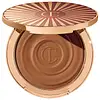Chanel Les Beiges Healthy Glow Bronzing Cream Versus Charlotte Tilbury Beautiful Skin Sun-Kissed Glow Bronzer
What's inside
What's inside
 Key Ingredients
Key Ingredients

 Benefits
Benefits

 Concerns
Concerns

 Ingredients Side-by-side
Ingredients Side-by-side

Dimethicone
EmollientHydrogenated Coconut Oil
EmollientSilica Dimethyl Silylate
EmollientSilica
AbrasivePolymethylsilsesquioxane
Paraffin
PerfumingPhenyl Trimethicone
Skin ConditioningMethylpropanediol
SolventSynthetic Wax
AbrasiveKalanchoe Pinnata Leaf Extract
MaskingHydrogenated Microcrystalline Wax
Emulsion StabilisingCaprylyl Glycol
EmollientParfum
MaskingPhenylpropanol
MaskingLecithin
EmollientTocopherol
AntioxidantAscorbyl Palmitate
AntioxidantGlyceryl Stearate
EmollientMaltodextrin
AbsorbentGlyceryl Oleate
EmollientCitric Acid
BufferingBHT
AntioxidantCI 77007
Cosmetic ColorantCI 77491
Cosmetic ColorantCI 77492
Cosmetic ColorantCI 77499
Cosmetic ColorantCI 77891
Cosmetic ColorantMica
Cosmetic ColorantDimethicone, Hydrogenated Coconut Oil, Silica Dimethyl Silylate, Silica, Polymethylsilsesquioxane, Paraffin, Phenyl Trimethicone, Methylpropanediol, Synthetic Wax, Kalanchoe Pinnata Leaf Extract, Hydrogenated Microcrystalline Wax, Caprylyl Glycol, Parfum, Phenylpropanol, Lecithin, Tocopherol, Ascorbyl Palmitate, Glyceryl Stearate, Maltodextrin, Glyceryl Oleate, Citric Acid, BHT, CI 77007, CI 77491, CI 77492, CI 77499, CI 77891, Mica
Dimethicone
EmollientTriethylhexanoin
MaskingCeresin
Emulsion StabilisingPolymethylsilsesquioxane
Dimethicone Crosspolymer
Emulsion StabilisingTrimethylsiloxysilicate
EmollientPolyethylene
AbrasiveDimethicone/Polyglycerin-3 Crosspolymer
CleansingSilica
AbrasiveMica
Cosmetic Colorant7-Dehydrocholesterol
Emulsion StabilisingC10-18 Triglycerides
EmollientSodium Hyaluronate
HumectantTriolein
Skin ConditioningGlyceryl Dioleate
EmollientDipropylene Glycol
HumectantSodium Citrate
BufferingTocopherol
AntioxidantCI 77891
Cosmetic ColorantIron Oxides
Dimethicone, Triethylhexanoin, Ceresin, Polymethylsilsesquioxane, Dimethicone Crosspolymer, Trimethylsiloxysilicate, Polyethylene, Dimethicone/Polyglycerin-3 Crosspolymer, Silica, Mica, 7-Dehydrocholesterol, C10-18 Triglycerides, Sodium Hyaluronate, Triolein, Glyceryl Dioleate, Dipropylene Glycol, Sodium Citrate, Tocopherol, CI 77891, Iron Oxides
 Reviews
Reviews

Ingredients Explained
These ingredients are found in both products.
Ingredients higher up in an ingredient list are typically present in a larger amount.
Ci 77891 is a white pigment from Titanium dioxide. It is naturally found in minerals such as rutile and ilmenite.
It's main function is to add a white color to cosmetics. It can also be mixed with other colors to create different shades.
Ci 77891 is commonly found in sunscreens due to its ability to block UV rays.
Learn more about CI 77891Dimethicone is a type of synthetic silicone created from natural materials such as quartz.
What it does:
Dimethicone comes in different viscosities:
Depending on the viscosity, dimethicone has different properties.
Ingredients lists don't always show which type is used, so we recommend reaching out to the brand if you have questions about the viscosity.
This ingredient is unlikely to cause irritation because it does not get absorbed into skin. However, people with silicone allergies should be careful about using this ingredient.
Note: Dimethicone may contribute to pilling. This is because it is not oil or water soluble, so pilling may occur when layered with products. When mixed with heavy oils in a formula, the outcome is also quite greasy.
Learn more about DimethiconeMica is a naturally occurring mineral used to add shimmer and color in cosmetics. It can also help improve the texture of a product or give it an opaque, white/silver color.
Serecite is the name for very fine but ragged grains of mica.
This ingredient is often coated with metal oxides like titanium dioxide. Trace amounts of heavy metals may be found in mica, but these metals are not harmful in our personal products.
Mica has been used since prehistoric times throughout the world. Ancient Egyptian, Indian, Greek, Roman, Aztec, and Chinese civilizations have used mica.
Learn more about MicaPolymethylsilsesquioxane is a silicone used as a film forming agent.
When applied to the skin, this ingredient creates an invisible film on the surface. This film still allows oxygen to pass through, but prevents moisture from escaping. This can help condition and hydrate the skin. It also leaves a silky feel when applied.
Polymethylsilsesquioxane has not been shown to clog pores. It has been deemed safe to use up to 55%, but most cosmetics use much less.
If you have concerns about using this ingredient, we recommend speaking with a professional.
Learn more about PolymethylsilsesquioxaneSilica, also known as silicon dioxide, is a naturally occurring mineral. It is used as a fine, spherical, and porous powder in cosmetics.
Though it has exfoliant properties, the function of silica varies depending on the product.
The unique structure of silica enhances the spreadability and adds smoothness, making it a great texture enhancer.
It is also used as an active carrier, emulsifier, and mattifier due to its ability to absorb excess oil.
In some products, tiny microneedles called spicules are made from silica or hydrolyzed sponge. When you rub them in, they lightly polish away dead skin layers and enhance the penetration of active ingredients.
Learn more about SilicaTocopherol (also known as Vitamin E) is a common antioxidant used to help protect the skin from free-radicals and strengthen the skin barrier. It's also fat soluble - this means our skin is great at absorbing it.
Vitamin E also helps keep your natural skin lipids healthy. Your lipid skin barrier naturally consists of lipids, ceramides, and fatty acids. Vitamin E offers extra protection for your skin’s lipid barrier, keeping your skin healthy and nourished.
Another benefit is a bit of UV protection. Vitamin E helps reduce the damage caused by UVB rays. (It should not replace your sunscreen). Combining it with Vitamin C can decrease sunburned cells and hyperpigmentation after UV exposure.
You might have noticed Vitamin E + C often paired together. This is because it is great at stabilizing Vitamin C. Using the two together helps increase the effectiveness of both ingredients.
There are often claims that Vitamin E can reduce/prevent scarring, but these claims haven't been confirmed by scientific research.
Learn more about Tocopherol